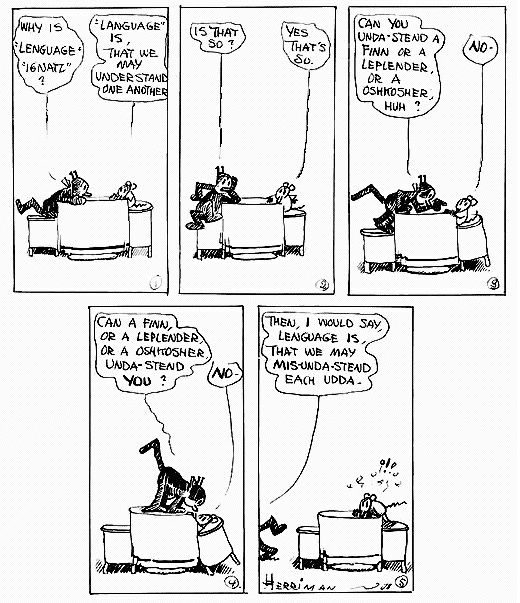|
Instructor: John
Lawler (jlawler@umich.edu) Prerequisites: None. This is the basic course, 10-12 MTWTh, 1624 Chemistry, 5/4 - 6/17/99 (Note Room Change) |
Credits: 4 Distribution: Social Science (SS) ... at least officially, |

True, all true. As Krazy suggests, this "massive and inclusive art" is also the information bottleneck of the human condition. A vast amount of our knowledge, including virtually everything we learn in formal education, comes to us through Language. Consequently, learning to analyze language, in ways that work for all languages, and to describe it objectively, is an indispensable tool for intellectuals, and one that stimulates in addition the habit of close attention to language, which is one of the things necessary for effective writing, not to mention clear thinking. Further, an understanding of how language really works (in contrast to the linguistic mythologies usually taught in schools) gives one a metaphorical place to stand that facilitates the study of anything that is described in language, which means just about everything.
Over the last century, linguistic scientists have amassed an array of analytic procedures, concepts, and findings that allow one to de-mystify speech, grammar, and language use, and to discover a number of surprising facts about one's own and others' languages. This course is a small (maximum 30) 8-week, 4-credit intensive introduction to the methods linguists use for describing languages (although general training in analytic thought is our ultimate goal). We will meet Monday through Thursday, for four two-hour classes a week, from Tuesday, May 4th through Thursday, June 17th.
Drawing on examples from a large number of the world's languages, we will devote one week to each of the major areas of linguistic analysis, in order:
There will be weekly quizzes and daily data analysis problems, which will form the context for our discussion. In addition, there will be a comprehensive final take-home exam, which may be done in groups. This class is especially recommended for those with interests in scientific analysis (including mathematics, computing, and engineering), since the analytic methods discussed are generalizable easily.
There is no textbook; materials for analysis and handouts are in a coursepack. No prerequisites except an interest in language and thinking.
Check
Times, Location, and Availability
John
Lawler
Linguistics Program
University of Michigan, Ann Arbor,
MI 48109 USA